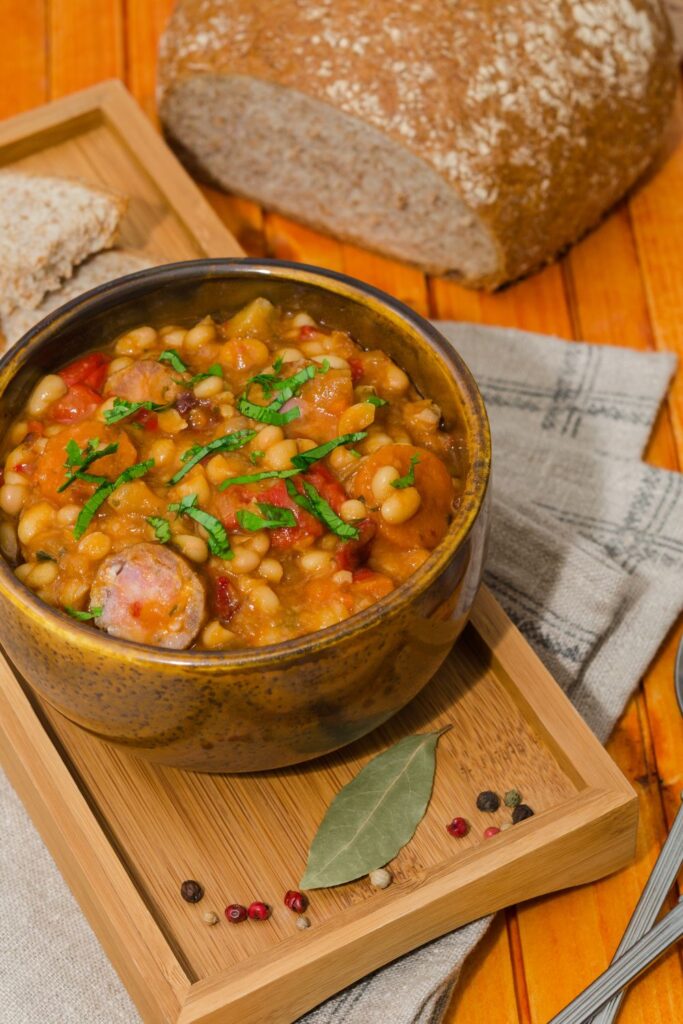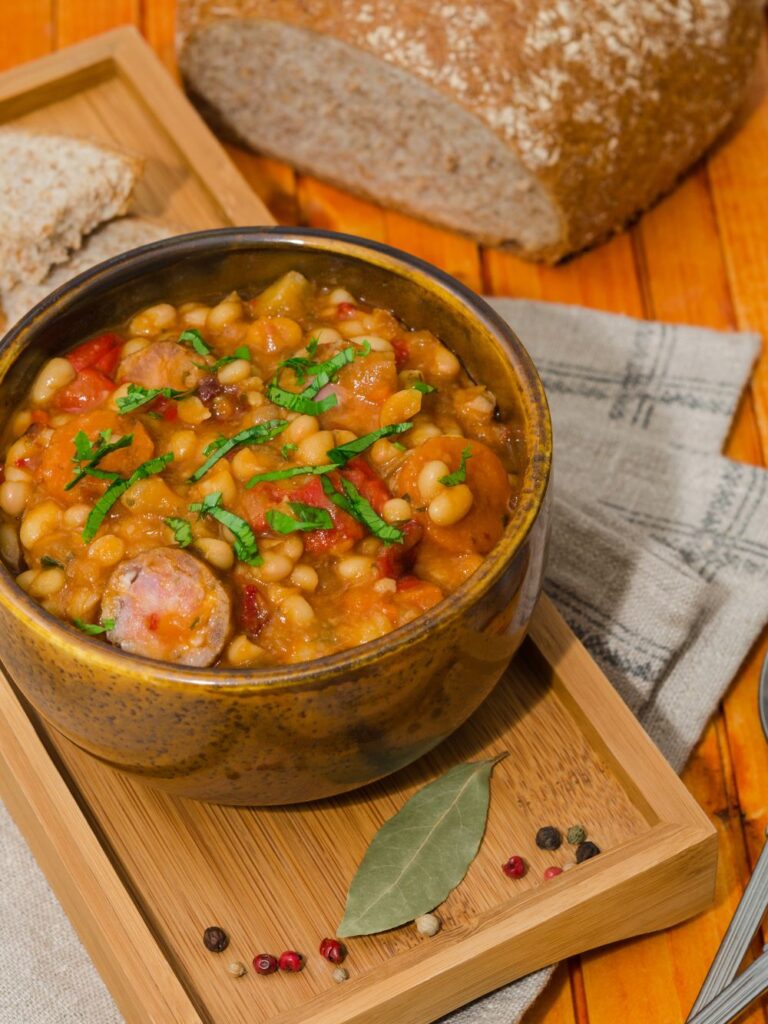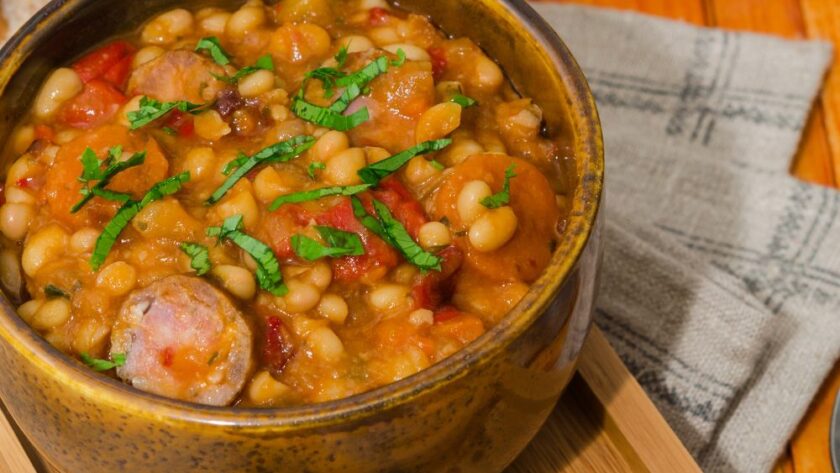Let me be honest — this isn’t a 30-minute supper you throw together while watching the telly and texting your mate back. No. This is the kind of dish you make when you’re ready to slow down, fill the house with savoury smells, and feel a little bit like you’re cooking in the French countryside with a big pot and a glass of red.
Rick Stein’s cassoulet is rich, old-school, and full of those meaty, stewy flavours that taste even better the next day. I made it on a grey Sunday, no plans, just the sound of the rain and the bubbling of beans and sausage in the oven. I had to stop myself from tearing off a chunk of bread and dipping it straight into the pan halfway through. Honestly? Worth every bit of effort.
This is proper food. Built to feed hungry souls and impress the table without a hint of snobbery.
Why You’ll Love It
- It’s deeply comforting — soft beans, crispy sausages, melt-in-your-mouth duck.
- Feeds a crowd — or keeps you happy all week with leftovers.
- Even better the next day — like a stew, it just gets richer with time.
- The crust! — golden, bubbling, and full of flavour from all that duck fat.
- Real French vibes — without needing to fly to Carcassonne.
- Rustic, hearty, and totally satisfying.
Ingredients
- 500g home-salted pork belly
- 65g duck or goose fat
- 1 whole head garlic, peeled and sliced
- 1 large onion, chopped
- 1kg dried haricot blanc beans, soaked overnight
- 1 bouquet garni (leek, celery, thyme, bay leaves, parsley stalks)
- 6 Toulouse sausages (or other good garlicky sausages)
- 4 duck confit legs, each cut in half at the joint
How to Make It
Start with the pork:
Cut the pork belly into big, rustic chunks — I go lengthwise into 3 strips, then across into bite-sized pieces. They’ll soften up beautifully while cooking.
Gently fry your base:
In a large, flameproof casserole (something heavy), melt about 50g of the duck fat. Add the garlic and onion and let them soften slowly over low heat. Don’t rush — no browning, just mellow and fragrant.
Build the bean base:
Add the drained beans and pork to the pot along with 1.75L of water and your bouquet garni. Bring to a gentle boil, skim off any scum, cover, and bake at 180°C (350°F) for an hour. The beans should be almost tender — think soft but not falling apart.
Brown your sausages:
While the beans are baking, heat the rest of the duck fat in a frying pan. Brown the sausages on all sides until they’ve got a lovely colour. Let them cool slightly, then cut each one into 3 chunky pieces.
Assemble the cassoulet:
Take the pot out of the oven and turn the heat up to 220°C (425°F). Nestle the sausages and duck confit pieces into the beans — press them in so everything gets cosy. You want some bits sticking out to crisp up.
Bake for the final crust:
Pop it back in the oven uncovered for about 45 minutes. The top will go deep golden, and the liquid should reduce to a rich, almost sticky sauce. If the top browns too fast, loosely tent it with foil.
Serve it like the French do:
Bring the whole pot to the table. Don’t faff with plating. Let people dig in with big spoons and warm bread on the side.

Common Mistakes and How to Dodge Them
Why are my beans still hard?
Old beans take longer to cook — soak them overnight and simmer longer if needed. Or try Great Northern beans if you’re stuck.
It’s too greasy!
It’s cassoulet — it’s meant to be rich. But you can trim some fat off the pork or duck if you really must. (I wouldn’t.)
Top isn’t browning.
Turn up the heat or move it under the grill for a few minutes — keep watch or you’ll burn it!
It’s too thick/dry.
Add a splash of hot stock or water toward the end if it looks too tight. But don’t flood it — you want it thick and spoonable.
Storage and Reheating
- Fridge: Cool it down, cover tightly, and keep for up to 4 days.
- Freezer: Portion into containers and freeze for up to 3 months. Defrost in the fridge overnight before reheating.
- Oven: Reheat covered at 180°C for 30 minutes or until bubbling.
- Stovetop: Gently heat in a pot with a splash of water or stock, stirring now and then.
- Microwave: Yes, you can — medium power, stir every 30 seconds.
Frequently Asked Questions
Can I make cassoulet ahead of time?
Absolutely. It actually improves after a day or two — more flavour, thicker texture.
What’s a good bean substitute?
Cannellini or Great Northern beans are closest in texture. Tinned beans work in a pinch, but skip the initial hour of baking.
Is duck confit essential?
For that authentic French flavour? Yes. But you can swap for chicken thighs cooked in duck fat if needed.
Can I make it vegetarian?
Technically no — it wouldn’t be a cassoulet. But you can make a lovely bean stew inspired by it, with smoked paprika and veggie sausage.
Nutrition Facts (Per Serving):
- Calories: 489 kcal
- Fat: 30g
- Saturated Fat: 9.9g
- Carbs: 27g
- Fibre: 3.6g
- Sugar: 4.5g
- Protein: 25g
- Sodium: 762mg

Rick Stein Cassoulet
Description
A deeply satisfying French classic packed with creamy beans, garlicky sausage, tender duck confit, and a golden crust that makes it utterly unforgettable.
Ingredients
Instructions
- Cut pork belly into chunks. Preheat oven to 180°C.
- Sauté garlic and onion in duck fat until soft.
- Add beans, pork, water, and herbs. Bring to boil, skim, cover, bake 1 hour.
- Brown sausages in leftover duck fat, then slice.
- Increase oven to 220°C. Nestle sausages and duck into beans.
- Bake uncovered 45 mins until golden and crusty.
- Serve straight from the pot with bread.
Notes
- Soak your beans overnight — don’t skip this.
- Duck fat = flavour. But use olive oil if desperate.
- Always taste your broth before the final bake — salt matters.
- Serve with crusty French bread and something green.

